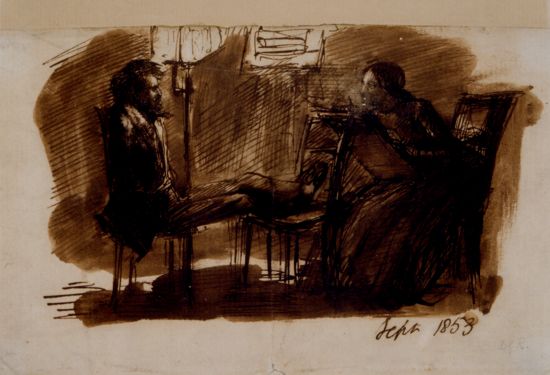
I’ve spent years reading about the relationship between Dante Gabriel Rossetti and Elizabeth Siddal. One thing I’ve noticed through comments and emails I receive at lizziesiddal.com is that there are a lot of people who are so sympathetic towards Lizzie that they passionately hate Rossetti. When you learn about people, I think a story forms in your head and it’s easy to cast them as villains or saints. We like to have someone to root for and someone to vilify. Even though I am obsessively interested in Lizzie Siddal, I simply can’t bring myself to dislike Rossetti. He intrigues me. I do not approve of some of his choices. He was complex and deeply flawed. But good lord, could that man paint a goddess:
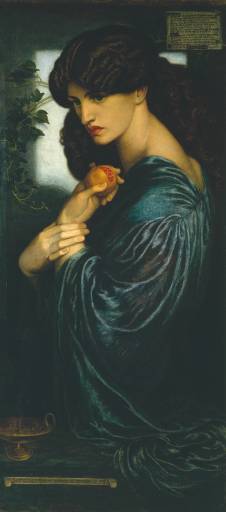
Lizzie was discovered by artist Walter Howell Deverell while she was working in a millinery shop and appears in his painting Twelfth Night. This introduction to the Pre-Raphaelite circle led to her appearance in several works such as Ophelia by Millais and Valentine Rescuing Sylvia by Holman Hunt. Eventually, she posed only for Dante Gabriel Rossetti.
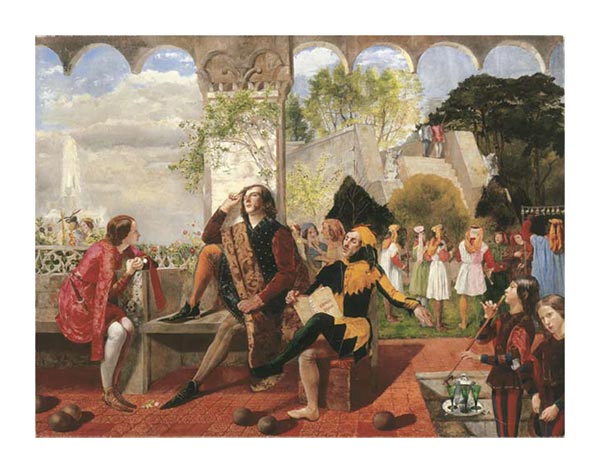
Lizzie sat exclusively for Gabriel and he drew and painted her image obsessively. Again and again, he captured her likeness. When she expressed an interest in creating art instead of just posing for it, he became her mentor. This is the part of their relationship that I most enjoy, I like the idea of a couple inspiring each other artistically and creating together. Gabriel encouraged and supported her work, even helping to secure John Ruskin as her patron.
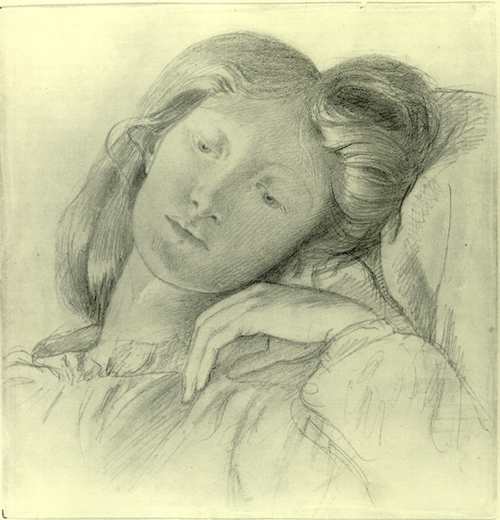
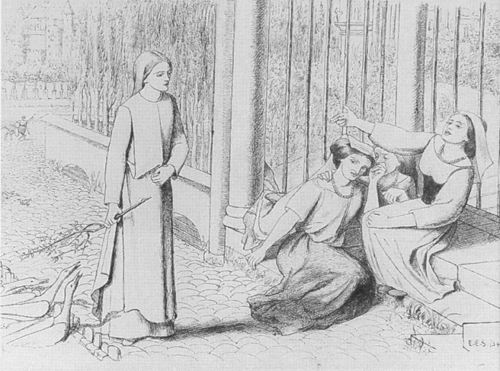
All of this seems promising, a couple who loves each other and whose lives revolve around their art. Where did it go wrong? At some point, Lizzie developed a reputation for being in ill-health and began to use Laudanum, which was quite common at the time. It’s also apparent that Rossetti had placed her on a pedestal, she was someone to be loved from afar, idealized and admired as an artistic muse and not as a flesh and blood woman. His sister, the poet Christina Rossetti, alludes to this in her poem In An Artist’s Studio:
One face looks out from all his canvasses,
One selfsame figure sits or walks or leans;
We found her hidden just behind those screens,
That mirror gave back all her loveliness.
A queen in opal or in ruby dress,
A nameless girl in freshest summer greens,
A saint, an angel; – every canvass means
The same one meaning, neither more nor less.
He feeds upon her face by day and night,
And she with true kind eyes looks back on him
Fair as the moon and joyful as the light:
Not wan with waiting, not with sorrow dim;
Not as she is, but was when hope shone bright;
Not as she is, but as she fills his dream.
Their on and off relationship lasted close to a decade before they finally married. Prior to marriage, there had been troubles. It seemed Rossetti had been infatuated with model Annie Miller, who was involved with artist William Holman Hunt. Lizzie developed a dislike towards both Annie and Holman Hunt. Both Lizzie and Rossetti were moody and temperamental, which no doubt added to their friction. The relationship must have been dizzying, he could shift between neglectfulness due to his attentions towards other women to being suddenly attentive and rushing to her side when she was ill. And since she was so often ill — and so often recovered — it has been suggested that at times her illness was an attempt to manipulate Rossetti and play upon his sympathies. He later discovered both Fanny Cornforth and Jane Burden (later Morris). I can’t say to what level his intimacy with them reached during this point in his life, but he was definitely captivated and Lizzie’s position as his only muse had been altered irrevocably. She still remained a muse, but it was now a title she would share with more than one woman.
There were many times during their courtship when they endured separations: she traveled for her health and once even attended an art school in Sheffield, which shows that she was serious in her pursuits and that her artistic endeavors did not exist only in relation to Rossetti. Eventually, though, her illnesses were more real than ever. No longer manipulations, but serious physical problems that most likely stemmed from her extensive Laudanum use. The alcohol/opiate derivative had taken its toll.
In 1860, Lizzie was staying in Hastings and was so ill that her family believed her to be dying. Rossetti was summoned to her side. He’d seen her ill many times before, but this time, there must have been a sense of great urgency because finally he was ready to marry her. Together they had a history of nine years. Nine years of creating art, fueling their creativity, fighting passionately over various things and I’m sure that all of that history fed his desire to rescue Lizzie and to do that noble thing that he always said he intended to do. He married her.
The Rossetti marriage was fated to last two years. Despite her illness, they were able to make it to Paris for their honeymoon. Their marriage was spent pursuing artistic endeavors and spending much time with fellow artists Burne-Jones and William Morris. Rossetti and his bride contributed a great deal to the decorating of Morris’ Red House and I can picture that time as one filled with joy and creativity, a time of new beginnings and possibilities.
Sadly, Lizzie was still hopelessly addicted to Laudanum. She became pregnant and their joy for upcoming parenthood was quickly dashed as grief set in when she lost the baby. Their daughter was stillborn, quite likely because of Laudanum. Lizzie was distraught, caught in a world of depression, grief and addiction. Lucinda Hawksley describes this period in Lizzie Siddal: The Tragedy of a Pre-Raphaelite Supermodel:
Following the loss of her child, Lizzie was permanently altered. She would sit in the drawing room for hours without moving her position, just staring silently into the fire. If there was no fire, she would simply stare into space, apparently not seeing anything in front of her. Once she refused to eat and became increasingly emaciated. The nurse hired as a maternity carer was living with them and taking care of her, but Lizzie was too wrapped up in grief to be aware of anything except her loss. When Ned [Burn-Jones] and a heavily pregnant Georgie [Burne-Jones] came to visit her, Lizzie was in her room alone, staring at the empty baby’s cradle, which she would rock tenderly from side to side as though soothing her daughter to sleep. As the door creaked open she looked up and told them to be quiet so as not to wake the baby. The pregnant Georgie found this heart-rendingly sad; Ned thought Lizzie was being ridiculously over-dramatic.
I almost can’t bear how sad that is, the image of Lizzie rocking an empty cradle, the ghost of a child. It’s interesting to see the differing reactions of Burne-Jones and his wife. Georgie instantly feels compassion for Lizzie while Ned feels it is needless melodrama. Different gender reactions and levels of understanding towards emotional issues seem to be a recurrent theme of the time. Well, of many times since it’s not something limited to the Victorian era. Women swoon, men carry on with a stiff upper lip. When she later became pregnant again, who knows what her emotional states must have been? Still an addict and not fully recovered from the previous tragedy, she must have been in a precarious emotional state. On February 10, 1862, pregnant Lizzie, Rossetti, and poet Algernon Swinburne dined together. Later that evening, Rossetti had an engagement at Working Men’s College. When he returned, she was in a coma due to an overdose of Laudanum. He summoned a doctor and when Rossetti was unable to accept that the doctor could not save her, he summoned three more. Lizzie passed away in the early hours of February 11, 1862.
Most descriptions of Lizzie state that she committed suicide. I do not believe it was purposeful. Of course, it was self-inflicted as all addicts’ deaths are once they have spiraled out of control. But I don’t believe Lizzie set out to kill herself and though there are documented stories of a destroyed suicide note, it seems to be hearsay that we can’t possibly prove.
Lizzie’s image continued to haunt Rossetti after her death. He memorialized her in his painting Beata Beatrix, a tribute to Lizzie that incorporates a poppy flower being delivered to her hands by a dove. Opium is derived from poppies; the dove delivers to her the very source of the ingredient that killed her.
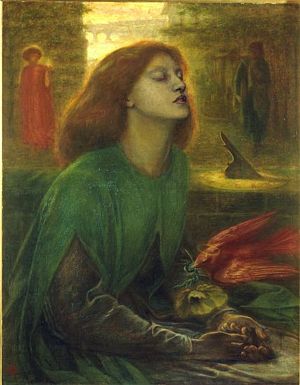
The Rossetti marriage was cemented into literary and art history by the macabre act of having Lizzie’s grave exhumed seven years after her death so that Rossetti could retrieve the manuscript of poems that he had buried with her. In my opinion, it was a terrible thing to do. Although without that act many people would not know who Lizzie Siddal was — it is so strange and fascinating that when people read of it, they are compelled to find out more about her. I have experienced that compulsion. It was the beginning of my journey to learn all I could about Lizzie and her life and work.
As I write this post, I realize that the Rossetti marriage, like so many marriages, was filled with missed opportunities. I feel sad for both of them, that neither of them seemed to get what they wanted out of their relationship and that they were plagued with trouble and tragedy.
I end this with Elizabeth Siddal’s own words:
Gone
To touch the glove upon her tender hand,
To watch the jewel sparkle in her ring,
Lifted my heart into a sudden song
As when the wild birds sing.
To touch her shadow on the sunny grass,
To break her pathway through the darkened wood,
Filled all my life with trembling and tears
And silence where I stood.
I watch the shadows gather round my heart,
I live to know that she is gone
Gone gone for ever, like the tender dove
That left the Ark alone.

Dante & Lizzie, love among the ruins …
Lizzie was a goddess
Hello Stephanie,
I thought you may like to know that I was born and lived in Hastings for 52 years.I am very familiar with the old town of Hastings and Lizzie and Gabriels places and history there. x
Great post! Love this passage: “I simply can’t bring myself to dislike Rossetti. He intrigues me. I do not approve of some of his choices. He was complex and deeply flawed. But good lord, could that man paint a goddess” Did you ever read Violet Ryan’s book? Not complementary depiction of Rossetti.
She didn’t write a complementary depiction of anyone, really.
Great post. So many of these things I read, though, and want footnotes! For example, Hawksley’s comments about Lizzie and the cradle… I assume those are from Georgina’s letters? I also didn’t know she was pregnant again when she died, where did you find that? Such a rich story… but I do think she was a smart and complicated woman. Rossetti was an ass at times, but shouldn’t be vilified.
I like that passage, too. Sums up my feelings, and I supect those of many others also.
There a several sources that mention the second pregnancy. The most readily available to me right now as I type this is again Lucinda Hawksley’s book saying: “At around twenty past seven in the morning of February 11,1862, Lizzie Rossetti was pronounced dead by all four doctors present. She was just 32 years old and pregnant — yet another baby destined not to survive”. Yes, the quote about the rocking of the cradle comes from Georgiana Burne-Jones, another woman with whom I sympathize greatly. I do believe the pregnancy is also mentioned in Jan Marsh’s Pre-Raphaelite Sisterhood, but I don’t have it in front of me right now so I can’t confirm.
What a great post, I share your opinion, I feel so sorry for them… What they could have done together if they understood themselves better… It’s a shame.
Oh, and I suppose you already know but booking for the Lizzie event is already available!
Thanks! I’ll check that.. and btw I really meant Hawksley when I commented about the footnotes. Curse of an academic 🙂
Thanks again wonderful lpost
Their relationship was a very sad one. Lizzie was using such a dangerous substance and there was no regulations on how it was made. One bottle could have been a lot stronger than another. She could have so easily taken an overdose. I do not think Rossettti was the biggest jerk around, but he could have been more faithful. So while they may have had feelings for one another, it did not lead to a happy marriage.
Loved reading your post, the marriages are compelling
I too find it hard to hate Rossetti. I like to think they
Had some golden times before they started slipping
Away from each other.
Love this series of posts, and of course this one is going to be dearest to my heart! 🙂 I’ve made my share of snarky comments at DGR’s expense, and I do tend to hold him most culpable.
At the end of the day, though, I keep coming back to the conclusion that perhaps their biggest problem was that they were too much alike…
I completely agree. They so loved each other. I think due to her degrading and long illness, Rossetti nor Lizzie knew how to live with it. He absolutely adored her. I always struggled with the fact of why he waited so long to marry her and did so by the time he thought he might lose her for good. It is a tragic story, but such a beautiful one.
I could never bring myself to hate DGR either. Much for the same reasons as you.
Even though he died 100 years before I was born, when I first read about the PRB, I instantly felt a sort of connection to Rossetti, and I remember seeing a piece of art in a book and I looked in the appendix to see who painted it because it was lovely and the piece was Astarte Syriaca. I’m not an artist and I’d never really had much interest in art history until I came across the PRB. I feel the same way you do in that I don’t agree with all of Rossetti’s decisions, and had I been one of his many lovers I am sure the man would have frustrated me to no end, but I cannot bring myself to hate him. Not even a little bit.
dear dove divine <3
My favorite!
I have this hanging in my bedroom